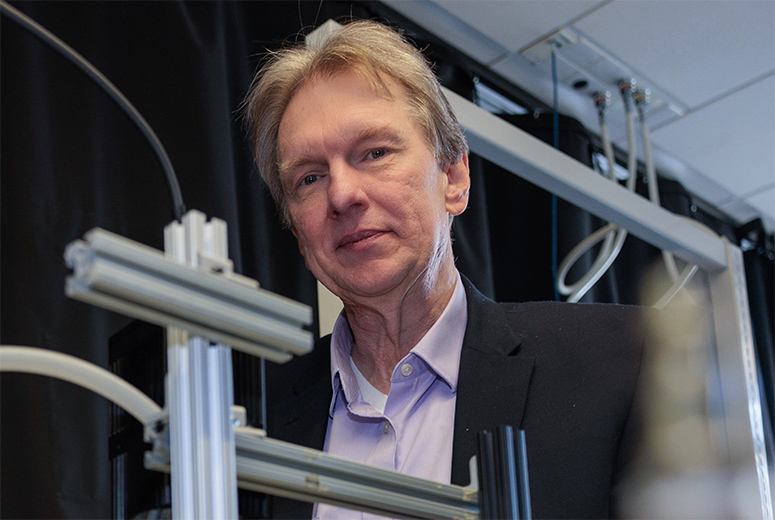
Going with the Flow(s)
Growing up on the Northwest Side of Chicago, Michael Plesniak (ME ’83, M.S. ’84) found himself following in the footsteps of his father, a machinist who immigrated to the United States. He spent much of his adolescent and teen life working on cars or “taking stuff apart.”
With that as his foundation, a career in mechanical engineering made sense—Plesniak figured that he would settle into a career designing auto parts or other mechanical systems. That was until he was introduced to a side of mechanical engineering that he was, until then, unfamiliar with: fluid dynamics, or the study of the flow of fluids (liquid and gas).
The introduction of fluid dynamics through an undergraduate research experience not only intrigued Plesniak, but set him on a three-decade (and counting) career path in academia, with time spent at NASA and the National Science Foundation.
“I remember [former Illinois Institute of Technology] Professor Mark Morkovin would say, ‘Well, if you really want to do research, you have to get a Ph.D. That’s the union card,’” says Plesniak, who earned his “union card” at Stanford University. “When I entered college, I thought I would get a bachelor’s degree. I would go out and become an engineer and work at GM or an automotive company. The undergraduate research experience is what set me on the path to, well, there’s this whole exciting area of research to be done.”
Plesniak, who is a professor and chair of George Washington University’s Department of Mechanical and Aerospace Engineering, now focuses his fluid dynamics research on human speech production and cardiovascular flows.
Plesniak’s initial foray into the field was through turbulence and turbulent flow physics, but he “was always interested in biological flows in the body.” At Purdue University, where he first became a professor, Plesniak began to research phonation, or the production of speech sounds.
His work evolved from there.
Eventually, Plesniak began to work with doctors and surgeons on multiple issues surrounding the vocal folds, including folds that were paralyzed or that had developed polyps, both of which can affect speech.
Surgeons have had a procedure to treat paralyzed vocal folds, which includes an insert being put on the vocal fold to improve speech. But the procedure, a medial laryngoplasty, was something of a trial and error, with a significant number of patients having to endure multiple procedures because the first (or second or third) didn’t have enough of an effect.
Plesniak’s experimental work, when combined with clinical results, helped in the development of computer simulations that surgeons can now use to maximize positive outcomes.
“As medicine’s becoming more and more high tech and they have more imaging capabilities and more control with robotic surgeries, physicians are trying to make it more predictive so that they can really plan what they’re going to do and have a better idea of the outcome rather than having to iterate on it afterward,” Plesniak says.
Exploring biological flows has even allowed him to incorporate concepts, such as turbulent flows, that tie back to the ideas that were his introduction to fluid dynamics. His work in cardiovascular flows—which are supposed to be smooth and regular—examines issues that lead to blockages and can result in stents being put into the coronary arteries.
The cardiovascular flows work has also led to real-world impact, including working with a startup to develop a product that prevents kidney failure during cardiovascular procedures such as coronary artery bypass. The product that Plesniak helped contribute to is still in use today.
“It’s interesting—I’m of a much older generation than his—but [Plesniak] has the same style we have at Caltech, looking at problems from a really basic [perspective] and trying to translate it to applications,” says Morteza (Mory) Gharib, Hans W. Liepmann Professor of Aeronautics and Medical Engineering at Caltech. “He’s really into understanding the basic research aspects of the work.”
Plesniak’s impact extends beyond his own work, too.
He leads George Washington’s Center for Biomimetics and Bioinspired Engineering, which aims to take the lessons that can be gleaned from nature and its evolution to inspire engineering decisions. One of its current projects includes studying how sea lions swim.
“They swim a lot differently than any other sea animals. Most fish and other animals mostly get their thrust from their tails, whether they move them side to side or up and down. Sea lions do something almost like a breaststroke with their fore flippers,” Plesniak says, adding: “Right now we’re making robots based on that. One application is designing amphibious vehicles.”
It’s a fitting continuation of a career that has taken Plesniak in directions that he would have never thought of growing up in Chicago’s Belmont Heights neighborhood and while taking auto shop classes at Lane Tech College Prep.
While the work is fundamentally different from designing car parts, Plesniak still remains firmly entrenched in his mechanical background.
“Everything’s related. There’s not that big of a difference between the mechanical structural side and the fluid side of mechanical engineering,” he says. “There are many other things in mechanical engineering that people do, but as the problems get more and more challenging and the world’s more interdisciplinary, we don’t work as individuals as much as on teams. All these different disciplines are brought to bear on these problems. And that’s really exciting.” •